Netherland Dwarf rabbit
The Netherland Dwarf is a breed of domestic rabbit that originated in the Netherlands. Weighing 1.1–2.5 pounds (0.50–1.13 kg),[1][2] the Netherland Dwarf is one of the smallest rabbit breeds. Its popularity as a pet or show rabbit may stem from its neotenic appearance. The Netherland Dwarf is recognised by both the American Rabbit Breeders Association (ARBA)[1] and the British Rabbit Council (BRC).[2] The Netherland Dwarf is often confused with the Polish breed of rabbit, but the latter has longer ears, a non-brachycephalic head and less cobbiness.
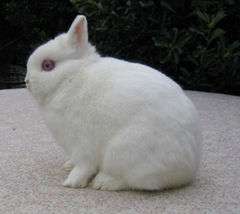
(Note the short ears, brachycephalic head and cobby body)
Ruby-eyed white colour variety

A Polish breed rabbit
(Note the longer ears and lack of brachycephalic head, with less cobbiness)
Ruby-eyed white colour variety
History
The Netherland Dwarf breed was first produced in the Netherlands in the early 20th century. Small Polish rabbits were bred with smaller wild rabbits;[3] after several generations the resulting animal was a very small domestic rabbit available in a wide variety of colours and patterns. Netherland Dwarfs were first imported into the United Kingdom in 1948.[3] In the 1960s and 1970s the United States imported its first Netherland Dwarf rabbits. The breed was accepted by the American Rabbit Breeders Association in 1969 using a modification of the British standard.[3]
Early dwarfs, even into the 1970s and 1980s, had fearful and sometimes aggressive temperaments. This was a result of breeders selecting wild breeding animals for their size. The first dwarf rabbits behaved more like these wild rabbits than domestic animals and were not good pets. However, through generations of selective breeding, the modern Netherland Dwarf has become a gentle, friendly pet rabbit, though it still can retain a more energetic disposition than larger breeds.
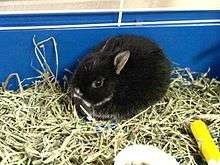
Appearance
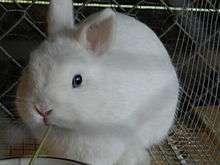
The Netherland Dwarf's head and eyes are disproportionately large with respect to its short-coupled and stout ("cobby")[4] body. Its ears are notably short and carried high on the head and its face is rounded and brachycephalic. These neotenic features, a result of dwarfism, cause the Netherland Dwarf to retain an infantile appearance even into adulthood.
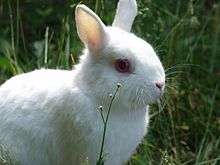
The Netherland Dwarf has been bred in a wide variety of colours, including: Ruby Eyed White, Blue Eyed White, Black, Blue, Chocolate, Lilac, Red, Siamese Sable, Siamese Smoke, Sealpoint, Blue Point, Chocolate Point, Tortoiseshell, Agouti, Red Agouti, Opal, Cinnamon, Lynx, Chinchilla, Squirrel, Tan, Marten Sable, Marten Smoke, Black Otter, Blue Otter, Chocolate Otter, Lilac Otter, Fox, Orange, Fawn, Hotot, Himalayan, Harlequin, Magpie, Broken, Butterfly and Mantle EMD.
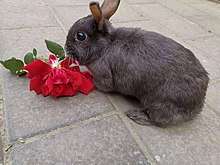
Netherland Dwarfs as pets
Due to their size and overall disposition, Netherlands Dwarfs often do not make good pets for children (although suitability will vary between individual rabbits). There is often a mismatch with small children, because they like to play with the pet or pick it up to cuddle with it. Dwarf rabbits do not like to be picked up or held tightly; and they can bite, scratch or struggle wildly if the child does so. This often leads to accidents if the child drops them out of fright, leading to major injuries because a rabbit has very fragile bones. Larger breeds of rabbits are recommended for children, because they have fewer issues with temperament.
However, dwarf rabbits can make excellent pets for adults. They thrive in a quiet, stable environment with plenty of human interaction. They are trainable, quiet and clean. Grooming needs are minimal, but the rabbit enjoys a daily brushing. Time is needed to bond with the rabbit and to build trust, because Dwarf breeds are often more nervous and more aloof than larger breeds. However, when the rabbit has bonded with their owner they make affectionate pets.
The expected lifespan of domesticated Netherland Dwarfs is 7-10 years. [5]
Behaviour
They can be litter-trained because they have a natural tendency to choose the same spot for their droppings and they have a much higher intelligence than most rabbits making it easier to litter train them.
Netherland Dwarfs can be skittish, wild and/or of a disagreeable nature. This is a leftover stereotype from the beginnings of the breed. This has changed through selective breeding; however, they are skittish and aloof. They are extremely active and energetic, requiring the same amount of exercise as other breeds of rabbit. They also have a higher tendency towards nervousness and stress. As with any species, disposition will vary from individual to individual.
Diet
Their diet consists of good quality pellets, veggies and an unlimited supply of hay. Root vegetables and fruit are high in sugar and should not be given often or in large amounts. Pellets should be fed in limited amounts—1/8 cup per pound of body weight. Vegetables,namely dark, leafy greens, should also be given, at 2 cups or more per 6 pounds of body weight.[6]
At a juvenile age, Netherland Dwarfs (as with most other rabbit breeds) should be fed unlimited quantities of alfalfa pellets and hay. As they age, the alfalfa should be gradually replaced with other hays and pellets. The pellets should be reduced to proportion with the weight of the rabbit.[7]
Dwarf breeds
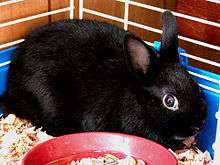
Rabbit breeds derived from breeding larger rabbits with the Netherland Dwarf (or any rabbit with a dwarf gene) are known as dwarf breeds. Most smaller breeds, like the Mini Rex, the Jersey Wooly, and the Holland Lop, are results of such breedings. Generally dwarf breeds are slightly larger than the typical Netherland Dwarf, not growing larger than 4 to 5 lb (1.8 to 2.3 kg). Most have shortened faces compared to larger rabbits, and some even preserve the rounded head, large eyes or small ears of the Netherland Dwarf. These features make them look little. Specifically, the Netherland Dwarf body should be round, compact and equally broad from front to back. Dwarf rabbits also have short legs and a large head in relation to the body. Their foreheads are broad and they have well developed muzzles. Furthermore, the eyes are large and prominent. Their ears are erect and close together, reaching between one and three inches in length. They have to be shorter than 2 inches and a half (ARBA), if not, this is a disqualification from competition in the Netherland Dwarf breed. Dwarf rabbits typically weigh 2 to 2.5 pounds according to ARBA.[8]
Breeding
The gene (symbol Dw) responsible for the common appearance of the dwarf was discovered in the United States during the beginning of the 20th century. When two "true dwarfs" (both buck and doe) are bred, the genetic pattern which makes them "true dwarfs" (Dwdw) ensures that 25 percentage of their offspring will inherit the lethal genetic combination dwdw. These offspring, often called "peanuts" by rabbit breeders, are destined to struggle with life for up to three weeks and then to die. Reasons behind the death are unknown, but it is believed that peanuts have underdeveloped digestive tracts. The condition is 100% fatal, although if fed by hand every hour and kept warm it is possible for a peanut to survive, even though it will be handicapped for its entire life. Many ethical breeders humanely euthanise peanuts upon finding them soon after birth. Peanuts are easily distinguished from non-peanuts; they have extremely pinched hindquarters, a bulbous head and their ears are often set further back than normal (sometimes almost onto the neck).
If two true dwarfs are bred, the statistical result will be 25% fatal 25% false, and 50% true. The actual numbers of true/false/peanuts in a real litter varies. "False Dwarfs" tend to have longer bodies, longer/larger ears, longer faces, and are mostly heavier than the 2.5 pound maximum weight for showing. While false dwarfs (referred to as BUD's by breeders, BUD meaning big ugly doe) do not make good show rabbits, does from a good background are vital to a breeder's programme. They have the same "good genes" as a true dwarf and are capable mothers, possibly even having larger and more successful litters than true dwarfs. Also False Dwarfs are unable to produce peanuts. Their litters will be 50% false dwarfs and 50% true dwarfs if they are bred to a true dwarf buck. False dwarfs are easily judged for quality as the traits are generally the same, only bigger. Ear thickness/shape, fullness of hindquarter, topline and other traits are the same.
It is common practice among Netherland Dwarf breeders to breed a proven show quality true dwarf buck to a quality false dwarf doe. This eliminates the chance of peanuts and yields quality offspring. The chances of false dwarfs is higher, but those offspring generally go toward breeding (some false dwarf bucks have proven themselves valuable to a breeding programme) or are sold as pets. Usually false dwarf bucks are not kept by breeders.
See also
References
- "ARBA Recognized Breeds". American Rabbit Breeders Association. Retrieved 5 April 2018.
- "Breed Standards 2016-2020" (PDF). British Rabbit Council. Retrieved 5 April 2018.
- American Rabbit Breeders Association (2000). Official Guide Book: Raising Better Rabbits & Cavies. Bloomington, IL: American Rabbit Breeders Association, Inc. p. 65.
- Baskett, Nancy K.; Newman, Jerry A., eds. (1 July 2014). 4-H Rabbit Project Leader Guide: Introduction, Glossary, and References (PDF) (WSU Extension Bulletin EM075E ed.). Washington State University. pp. 19, 25. Retrieved 5 April 2018.
Cobby — Short and stocky, close-coupled; very compact. Stocky — Compact, stout, and cobby.
- "Netherland Dwarf Rabbit Health Facts by Petplan". www.petplan.co.uk. Retrieved 2020-05-14.
- Proper Rabbit Maintenance Diet
- Rabbit Food - House Rabbit Society
- Wegler, Monika. "The Dwarf Breeds." My Dwarf Rabbit. Hauppauge, NY: Barron's, 2008. 26-31. Print.